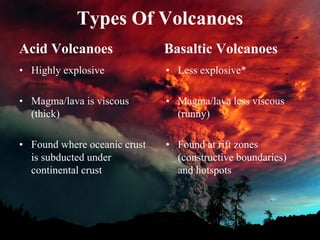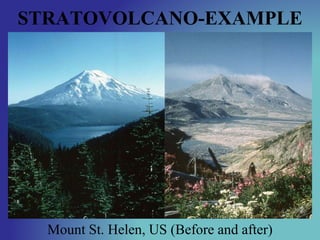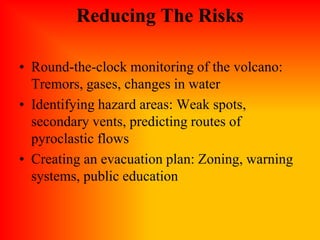Volcanoes - Types & Volcanic Hazards
- 2. ŌĆó It is point on the earthŌĆÖs crust where magma forces its way to the surface due to pressure. ŌĆó Ash and gases may also escape during a typical volcanic eruption. What is a volcano?
- 4. Layout Of A Volcano
- 5. Types Of Volcanoes Acid Volcanoes ŌĆó Highly explosive ŌĆó Magma/lava is viscous (thick) ŌĆó Found where oceanic crust is subducted under continental crust Basaltic Volcanoes ŌĆó Less explosive* ŌĆó Magma/lava less viscous (runny) ŌĆó Found at rift zones (constructive boundaries) and hotspots
- 6. Acid Volcanoes Lava Domes ŌĆó Formed of layers of lava high in silica ŌĆó Lava is viscous and does not flow very far ŌĆó Rounded Form ŌĆó Composed completely of lava Stratovolcanoes ŌĆó Also called composite volcanoes ŌĆó Formed of layers of lava and ashes ŌĆó Lava is viscous ŌĆó Distinct cone shape
- 7. LAVA DOMES-EXAMPLE Mount Chaiten, Chile
- 8. STRATOVOLCANO-EXAMPLE Mount St. Helen, US (Before and after)
- 9. Basaltic Volcanoes ŌĆó Also known as shield volcanoes ŌĆó Consists of widespread layers of lava and have low viscosity ŌĆó Silica content is low ŌĆó Low form spread over a great distance
- 11. Calderas Volcanoes ŌĆó Collapsed Volcanoes ŌĆó Magma chamber has emptied and the ground has sunk ŌĆó Often becomes a lake ŌĆó New volcanoes can form, or pressure can build from below, lifting the ground ŌĆó If acidic, this can cause a catastrophic eruption in the form of a ŌĆÖSuper VolcanoŌĆÖ
- 13. Hotspots ŌĆó Tectonic plate moves over a magma plume ŌĆó Occasionally erupts, creating a volcano
- 14. Major Hotspots
- 15. Volcanic Explosivity Index (VEI) TYPE DESCRIPTION EXAMPLE Hawaiian Gentle Kilauea Strombolian Explosive Stromboli Vulcanian Severe Nabro Pel├®an Cataclysmic Mt.Pel├®e Plinian Paroxysmal St.Helens Plinian/Ultra-Plinian Colossal Krakatoa Ultra-Plinian Super-Colossal Tambora Supervolcanic Mega-Colossal Yellow Stone Number 8 has never been experienced in human history The list has been simplified. See correct details here: http://www.unc.edu/~rowlett/units/scales/VEI.html
- 17. Volcanic Hazards Most hazards during eruptions are caused by what comes out of a volcano. In the next few slides, weŌĆÖll be seeing the different types of volcanic hazards.
- 18. Volcanic Hazards ŌĆō Lava Flows ŌĆó Mostly associated with basic volcanos ŌĆó Slow moving 1 ŌĆō 5 km/h ŌĆó Low risk to human life ŌĆó Cover large areas and destroy large amounts of infrastructure
- 19. Hazards ŌĆō Pyroclastic Flows ŌĆó Hot clouds of ash and gas ŌĆó Move downhill, close to the ground, following valleys ŌĆó High speed ŌĆō up to 500 km/h ŌĆó As far as 30 km ŌĆó Up to 7000 C ŌĆó Highly dangerous
- 20. Hazards - Lahars ŌĆó Occur on high volcanos covered in snow and ice, or wet mud/soil ŌĆó Eruption causes snow to melt, or lava mixes with mud ŌĆó Flows downhill like wet concrete
- 21. Hazards ŌĆō Ash Clouds ŌĆó Slow moving ŌĆó Weight of ash can collapse buildings ŌĆó Destroys crops, pollutes water ŌĆó Affects air traffic ŌĆó Can enter high atmosphere and cause cooling ŌĆō disrupting climate
- 22. Hazards ŌĆō Lava Bombs ŌĆó Molten rocks thrown out of volcano ŌĆó Pummice ŌĆō smaller rocks ŌĆó Travel short Distances ŌĆó Can Start Fires
- 23. Benefits Of Living Near a Volcanic Region ŌĆó Aesthetic beauty eg. Mount Fuji, Japan ŌĆó Mining of minerals and diamonds ŌĆó Geothermal energy and hot springs ŌĆó Highly fertile soils ŌĆō soft rocks and high mineral content
- 24. Predicting Volcanic Eruptions ŌĆó Monitoring seismic disturbances (tremors) ŌĆó Changes in volcano profile (shape) ŌĆó Chemical changes in groundwater ŌĆó Emissions of gases ŌĆó Thermal monitoring (temperature)
- 25. History Of Eruptions ŌĆó 1800 BC ŌĆō destruction of Bronze age settlements ŌĆō then several more times ŌĆó 79 AD ŌĆō destruction of Pompeii ŌĆó At least 40 times until the last eruption in 1944 ŌĆō witnessed by allied troops towards the end of WWII ŌĆó = once every 40-50 years
- 26. Reducing The Risks ŌĆó Round-the-clock monitoring of the volcano: Tremors, gases, changes in water ŌĆó Identifying hazard areas: Weak spots, secondary vents, predicting routes of pyroclastic flows ŌĆó Creating an evacuation plan: Zoning, warning systems, public education
- 27. References ŌĆó http://greenfieldgeography.wikispaces.com/IG CSE+Plate+Tectonics+and+GCSE+Plate+Te ctonics ŌĆó http://volcano.oregonstate.edu/ ŌĆó http://www.physicalgeography.net/fundament als/chapter10.html ŌĆó http://volcanoes.usgs.gov/hazards/index.php


























